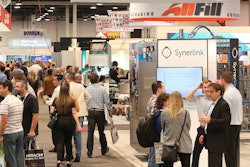PMMI’s State of the Industry Report has long served as a reliable baseline of machinery shipment statistics incorporated into an in-depth report on the packaging machinery industry. PMMI vice president of market development Jorge Izquierdo offers a 30,000-foot view of his initial findings from the exhaustive report. After two years of unprecedented growth, Izquierdo predicts sustained growth, but perhaps not at the levels of 2020 and 2021.
Download The State of the Industry Report
To subscribe, rate, review, and find more unPACKED podcast episodes, visit pmmi.org/podcast or find us on Apple podcasts, Spotify, iHeart Radio or wherever you listen to your podcasts.
 | Read the full transcript below
|
Sean Riley:
So, with all the fancy introductions out of the way, welcome back to the podcast, Jorge.
Jorge Izquierdo:
Hey, Sean. Thank you. Thank you for having me.
Sean Riley:
The pleasure is all mine. Now, you are, usually, for most of the year, knee-deep in business intelligence and the business intelligence that's coming out of PMMI. And I know that one of our reports that most people look forward to the most, at least specifically our members, I know, look forward to the most is our State of the Industry report. I just got my hands on the 2022 State of the Industry report. So since you know this as well as anyone, could you give us some of the key findings you've taken from this year's report?
Jorge Izquierdo:
Sure, Sean. Absolutely. 2021 and 2020 have been very busy years for the packaging machinery industry. In 2021, we had a growth of 11.2% for domestic shipments. The total market itself growth a rate of 12.1%, a total of close to $14 billion, $13.9 billion for the total market. And it's quite exciting. As I was saying earlier, it's been the growth in 2021, 11.2%. The growth in 2020 was even more than that, 14.7%. So our industry's coming from two very, very strong years, very likely a record year, a couple of years for many of our members. And as you can imagine, with all this demand and adding up some of the supply chain issues, the backlog is growing as well. Our backlog currently grows at a rate of 19.2% to reach $3.7 billion. So it's the highest we've seen in a while.
Sean Riley:
And I can't imagine the supply chain issues helping with the backlog.
Jorge Izquierdo:
Absolutely. I guess it's true for every industry. It doesn't matter where you are. Certainly, it's contributing to increasing the delivery times for packaging equipment. Yeah.
Sean Riley:
So it seems like, as you kind of note, 2020 and 2021 were very good years for packaging machinery orders. And it's interesting, and some industries have been up and down these past couple of years for some of the reasons that I think you're going to make clear. So what is it that has kind of kept packaging machinery above water and blossoming?
Jorge Izquierdo:
You know, it's very interesting, Sean. If we look back at these past two years, I guess the first clue... Well, number one, of course, it's COVID has been the culprit here in terms of what's happening. But to make it easier to understand, maybe just look at consumer behavior. We were forced to stay at home. We were not going to restaurants, events, hotels, or the office, as simple as that. We were mainly staying at home, most of us, and that means the way we consume was very different.
Jorge Izquierdo:
We concentrate a lot of our food came, well, mainly from supermarkets. So pretty much, that's one of the strengths of our industry. Everything that goes into a supermarket or most of the things that go into a supermarket are packaged. And because of that, we saw significant growing demand for packaging products. And because of that, of course, a significant growing demand for packaging equipment. So, it's been very interesting how the effects of COVID on the packaging industry and the significant increase in demand.
Sean Riley:
And, obviously, we're not completely out of the woods with the pandemic. So what do you attribute to why it's kind of stuck? Stuck, not COVID. I'm sorry, why have the packaging and processing machinery orders continued to be significant? Why has that stuck as we've sort of reemerged out of COVID a bit and are not completely away from the pandemic, but we're out more? It still seems like those numbers are high.
Jorge Izquierdo:
Yeah, for sure. Those numbers are high. And I would say we've been referring to the growth in 2020, and growth in 2021. PMMI tracks the quarterly behavior of the market with a different product that we call Quarterly Business Indicator. And pretty much includes a survey from PMMI members where we ask, "How's business."
Jorge Izquierdo:
And what we've been noticing is the first half of the year, the first quarter, already saw a significant slowdown on the pace of growth. I'm careful here with my wording, right? It's not shrinking.
Sean Riley:
MM-hmm. Right.
Jorge Izquierdo:
The growth is slowing down.
Sean Riley:
Okay. So maybe things are starting to... Again, we're not saying that they're going down, but you know, the astronomical growth is leveling off to very good growth at this point.
Jorge Izquierdo:
That's correct. In fact, the last couple of years, a lot of the investments have been devoted to growth to address the demands for growth. What we expect in coming years, and actually, towards the second half of this year and the coming couple of years, is that the demand will be driven more by trying to address the workforce challenges. You know? The lack of labor, availability of labor. So a lot of the investment will be driven by that, and very likely more heavy investments towards the end of the line, secondary packaging, and end-of-the-line equipment. It's what we are expecting for coming years.
Sean Riley:
Interesting. So a ton of things are changing, while a lot of things kind of stay the same. You've touched on a little bit with end-of-line and addressing workforce, but I guess, how has this changed? How have these last couple of years changed packaging and processing operations?
Jorge Izquierdo:
What's very significant is how the priorities have changed in packaging and processing operations. Just before COVID, in January 2020, operations were all about flexibility, quick changeover, productivity, asset reliability. And within a year, not any year, within a year of COVID, that changed significantly. By January 2021, the priorities were more on efficiency, throughput, and productivity, and automation, health, and safety for the employees. And safety has always been important, of course, but addressing health for the employees trying to avoid contagion.
Jorge Izquierdo:
It was kind of significant how we changed. That gives you an idea of how January 2021 was. When we asked people responsible for operations, packaging and processing operations, we asked them again in July 2020, just six months later, how the priorities have changed? We noticed that there was a significant change. The number one priority was addressing workforce challenges, followed by automation, productivity growth. And for the first time, we started looking at supply chain. And as we move into 2020, suddenly supply chain starts moving to the top. And things like delivery times are starting to come up in terms of priority number one for packaging operations.
Jorge Izquierdo:
So, it's been two years of significant changing priorities, significant and ongoing changing priorities. I don't think we are there yet when you're talking about getting back to normal. I think it's going to take still a few years to get there.
Sean Riley:
Right. And I guess a lot of the things that were, how do I say this, kind of altered for packaging and processing operations had to lead to an increase in remote and technologies and using the cloud and stuff like that. Are those things that we're still seeing on the increase?
Jorge Izquierdo:
You know, it's COVID. It's very interesting what happened there. So, sorry, Sean. I'm going to make a little longer answer of this question.
Sean Riley:
No problem.
Jorge Izquierdo:
COVID hit in, I guess, March, April 2020. As expected, many people responsible for packaging operations in CPG companies, they pretty much stopped allowing service technicians from the OEM side from entering their operations. So suddenly, from one month to the other, 70% of the service technicians weren't allowed to get into the packaging and processing operations. And, of course, this caused a significant problem for the industry.
Jorge Izquierdo:
And what happened is, somehow, many of those technologies, remote technologies that were already installing the equipment, but they were available, but many companies weren't were not using those technologies, suddenly they were forced to make the jump and to start using them. And the reason for not using them? There are many reasons, but among them it's cyber security. And it's a very important reason to be careful.
Jorge Izquierdo:
But many of the industries really looked at it, devoted the time to learn how to do it the right way. And in a few words, they were forced to jump in, right? And once they addressed these challenges in terms of remote access, other opportunities opened. It's not just remote access but cloud technologies, and these open the door for many of the Industry 4.0 opportunities for our industry. So I can tell you that COVID has been kind of a catalyzer for the industry in terms of adoption of not just remote but cloud technologies and Industry 4.0 technologies. It's certainly something that we've noticed significantly in the past two years.
Sean Riley:
Fair enough. So you touched on a little bit with your quarterly indicators, what we're starting to see. So, I guess, to kind of put a button on this talk, you've kind of given us where we are based off of the past, but I guess, what do you expect to see happen in the coming months and maybe the next year?
Jorge Izquierdo:
We are coming from two, pretty much, record years of growth, and it's not to be expected that we can keep this pace of growth for many years. So, what we're expecting is that the growth is going to slow down. Maybe we're going see a small contraction in the market. We're expecting something small, not major.
Jorge Izquierdo:
And again, maybe more in terms of not addressing growth, but addressing workforce challenges on one hand, on the other hand, packaging and processing innovation, new formats. So, I think those are the two areas where we are going to see investment. On the side of innovation, we'll be more on the primary packaging end. On the side of workforce, we're expecting that to happen more on the secondary packaging and end-of-line in the coming months and years.
Sean Riley:
Perfect. So we know what to look for as we move through the rest of 2022. And for our listeners out there, we know what they should be looking for at PACK EXPO International coming up in the fall.
Sean Riley:
I want to thank you again, Jorge, for taking time out of your day to come on here. So once again, thanks for kind of walking us through the 2022 State of the Industry report.
Jorge Izquierdo:
No. Thank you, Sean. It's always a pleasure to talk to you. Take care.


























